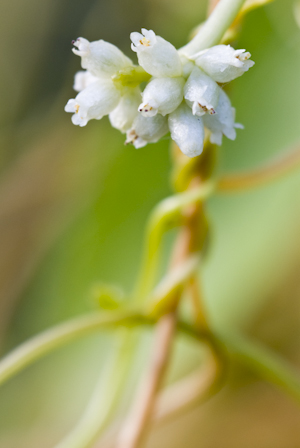Plants of South Florida · Plants by Conservation Area · Plants by County · Plants by Habitat Quick Search · Advanced Search |
||
|
|
||
 |
Cuscuta americana L. American dodder |
|
|
South Florida Status: Critically imperiled. One occurrence on disturbed private property in Miami-Dade County. Taxonomy: Dicotyledon; Convolvulaceae. Habit: Annual parasitic vine. Distribution: Native to peninsular Florida, the West Indies, Mexico, and South America. Wunderlin (1998) reports it as rare in Florida. It has been collected in South Florida, and in Lake and Polk counties (Wunderlin & Hansen, 2001). South Florida Distribution: Miami-Dade County and the Monroe County Keys. South Florida Habitats: Rockland hammocks, pinelands, and disturbed sites. Protection Status: Not listed by any agency. Aids to Identification: Austin (1980) has an illustration; Correll & Correll (1982) has an illustration. References: Yuncker, 1932; Small, 1933a; Long & Lakela, 1976; Austin, 1980; Correll & Correll, 1982; Wunderlin, 1998; Liogier & Martorell, 2000. Synonyms: None. Historical Context: John Kunkel Small and others first collected American dodder in 1925 in a rockland hammock on Lower Matecumbe Key (s.n., FLAS, NY). This is the only known collection from the Florida Keys. That same year, Ethel Z. Bailey made a collection in Coconut Grove in Miami-Dade County (6457, NY). It was collected in a pineland at Buena Vista in 1929 by Charles A. Mosier (s.n., NY), and again in 1930 by Mosier (s.n., NY) and Harold N. Moldenke (372a, NY). Buena Vista was located just north of present-day downtown Miami. Walter M. Buswell made several collections in Coral Gables beginning in 1940 (s.n., FTG), and ending in 1943 (s.n., FTG; s.n., NY). Robert T. Clausen and Buswell also made a collection in Coral Gables in 1943 (6231, NY). American dodder was not recorded again until 1999, when Bradley found it growing in a disturbed thicket across the street from Old Dixie Pineland in Naranja. Bradley vouchered this station in 2000 (2086, FTG). Major Threats: Habitat destruction. Comments: American dodder flowers in the summer through fall, when surveys should be conducted. Recommendations: • Map and monitor known stations annually. • Acquire Old Dixie Pineland site. • Consider establishing an ex situ collection of germplasm. • Assess appropriateness and study feasibility of introducing American dodder to other sites within its historical range, including the Old Dixie Pineland site and Klopp Tract, Lignumvitae Key Botanical State Park on Lower Matecumbe Key. • Assess appropriateness and study feasibility of restoring sandy pine rocklands near the Miami River and reintroducing American dodder. • Review for listing by FDACS and FNAI. |
||



